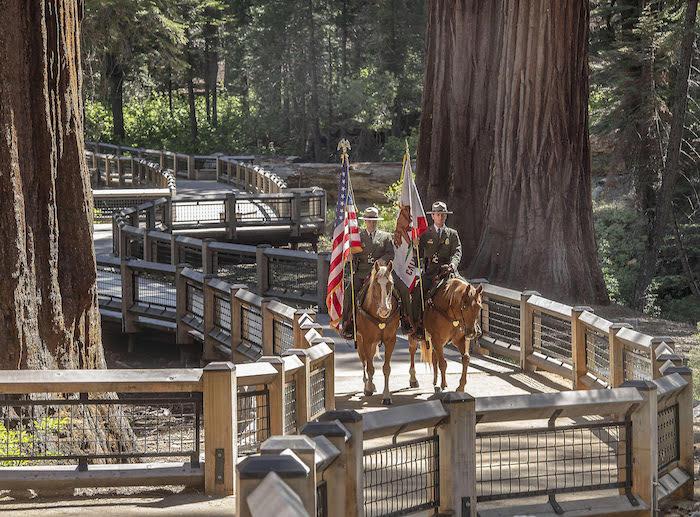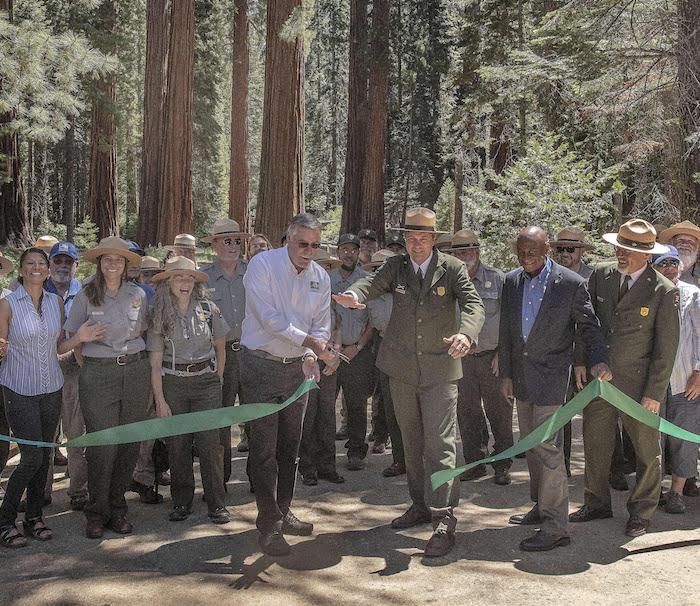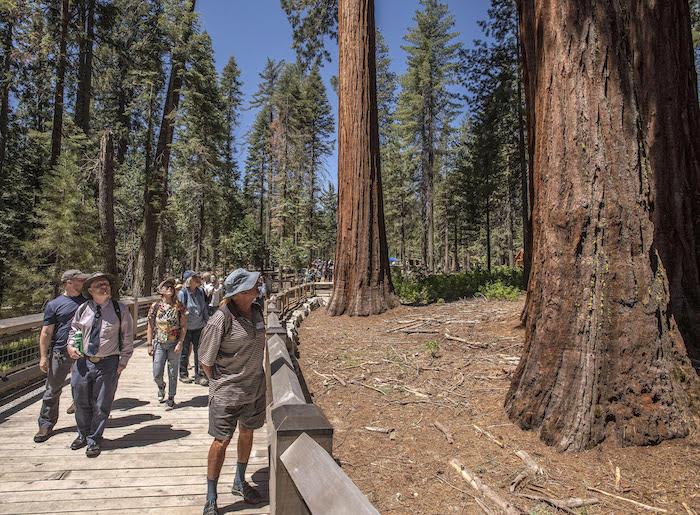
Mounted rangers present the colors at Yosemite's Mariposa Grove of Giant Sequoias/NPS
Nothing worthwhile is ever easily attained, but now, after three years of closure, you can return to the Mariposa Grove of Giant Sequoias in Yosemite National Park and marvel not only at the big trees but also the reinvigorated ecosystem.
“As the largest protection, restoration, and improvement project in park history, this milestone reflects the unbridled passion so many people have to care for Yosemite so that future generations can experience majestic places like Mariposa Grove,” said Yosemite Superintendent Michael Reynolds during a pre-opening celebration on Thursday. “These trees sowed the seeds of the national park idea in the 1800s, and because of this incredible project it will remain one of the world’s most significant natural and cultural resources.”
Mariposa Grove is home to about 500 mature giant sequoias, which are among the largest living things on Earth. The grove and Yosemite Valley were protected in 1864 as part of the Yosemite Grant Act, the nation’s first legislation focused on preserving public lands. The National Park Service and Yosemite Conservancy donors each provided $20 million to fund the $40 million project. The grove has been closed to the public since July 2015 when restoration activities began.
At a new arrival area, where shuttle busses will drop-off visitors, officials marked the grove reopening with a ribbon cutting and a tribal blessing. Speakers highlighted the grove’s historical significance, the importance of preserving our natural places, and the effectiveness of the National Park Service and Yosemite Conservancy partnership to accomplish exceptional work in the park.
“The grove restoration occurred because tens of thousands of people all invested in protecting a unique natural phenomenon,” said Yosemite Conservancy President Frank Dean. “Trails are supposed to take visitors someplace magical. Today, a walk in the grove has been transformed into a more beautiful and peaceful experience with the focus squarely on the trees.”

Frank Dean, president and CEO of the Yosemite Conservancy, and Yosemite Superintendent Mike Reynolds on Thursday cut the ribbon to mark the reopening of the Mariposa Grove of Giant Sequoias/NPS
A New Experience at Mariposa Grove
Instead of parking amid the grove, a visit today starts at the new Welcome Plaza near the park’s South Entrance, where a cross section of a fallen sequoia that lived for more than 800 years reminds visitors of the ancient place they are about to explore. From the plaza, visitors will take a free two-mile shuttle bus ride to the Grove Arrival Area where habitat grows in what was once parking areas for vehicles, tour busses, trams and employees. The grove’s trails are now made of natural surfaces instead of pavement, and wooden boardwalks hover over sensitive wetland to protect habitat and sequoia roots. Rattlesnake Creek is flowing again after culverts blocking waterflows were replaced by one of the elevated boardwalks. Another new trail invites people of all abilities to experience the famous Grizzly Giant and California Tunnel Tree.
“There is wetland or vegetation that was once pavement, but it’s impossible to know by looking now what was there before,” said Dean. “It is a remarkable transformation.”
A Yosemite Conservancy-funded assessment of Mariposa Grove became the foundation for the restoration plan. That survey, the first ever conducted in the grove, identified an estimated population of 5,803 trees of all sizes, including seedlings, saplings, juveniles and adults. Park biologists learned that 81 percent of the juvenile sequoias and 68 percent of saplings grow within 100 feet of wetlands, an important factor in the redesign of paths and installation of boardwalk to ensure the health of the grove.
Giant Sequoias can grow to be 300 feet high, 35 feet in diameter and 100 feet in circumference. One of the grove’s largest trees, the Grizzly Giant, is 209 feet tall and an estimated 1,800 years old. The grove is also home to more than 70 wildlife species, including rare wildlife such as pallid bats, Pacific fishers, and spotted owls.
Additional Project Facts
· Four acres of sequoia habitat restored.
· Four miles of trails built, including converting many roads within the grove to trails.
· 20,500 feet of asphalt removed or 1.44 acres, a 50 percent reduction.
· 600 feet of boardwalk and bridges installed to protect sequoia roots and improve hydrology that allows the grove to flourish.
· Accessibility throughout the lower grove area improved, as well as around the Grizzly Giant and California Tunnel Tree, with new universally accessible trails and ADA parking areas.
· New educational signage installed about sequoias, trails, stewardship, ecology and history, including greetings in the languages for the Traditionally Associated Tribes of Yosemite National Park.
· Unsightly vault toilets in the grove were removed and replaced with new restrooms with flush toilets in the South Entrance Welcome Plaza and Grove Arrival Plaza.
· Gift shop and tram tours were removed from the grove.
Visiting Mariposa Grove
· Mariposa Grove Welcome Plaza is located at the park’s Southern Entrance at Hwy. 41 and is open every day.
· Free shuttle busses from the Welcome Plaza to the grove depart in summer 8 a.m.-8 p.m.
· Yosemite Conservancy volunteers orient visitors and operate a new gift shop at the Welcome Plaza.
· Parking in the new Southern Entrance Welcome Plaza includes 285 spaces, eight accessible, and 16 oversized vehicle spaces, two of which are accessible.
· Parking at the trailhead to the grove, called the Grove Arrival Plaza, includes 33 spaces, and vehicles displaying valid disabled placards may drive there when the gate is open.
· More than 1 million people visit Mariposa Grove annually.

Guests invited to the dedication ceremony explore the Mariposa Grove of Giant Sequoias/NPS



Comments
i don't know, but from these pictures I would call the project overbuilt. There was nothing wrong with the old grove except too many people--which remains the salient problem in all of the great national parks. Now? I guess there remains a taste of wilderness here, but I would call it just a taste. We'll know when the first couple applies for a wedding permit on one of the walkways--and asks to close the grove.
Al--
From a natural resource or ecological perspective, there was _lots_ wrong with the old grove. We now know a lot more about the hydrology of the area and the wetlands / groundwater patterns of where sequoias grow. Most* sequoias grow in _groves_: filled in lake beds or meadows, apparently with a rather perched (trapped above rocks) water table. The roads & tiny culverts before the restoration pretty completely mangled the groundwater flows and Rattlesnake creek. The old conditions substantially increased the risk of the established trees dying during multi-year droughts. And the packed & paved trails impacted the relatively shallow roots of sequoias. My impression is that the altered hydrology was not as big of a factor as the earlier complete fire suppression, but something needed to be fixed to even come close to "unimpaired for the enjoyment of future generations". And restorng the wetlands & hydrology matters a great deal for many other species, too, not just the sequoias.
I agree with you about no wildness let alone wilderness there in Mariposa grove, although the restoration shuld _increase_ the taste of wildness, especially beyond the lower grove area. I suspect and hope that the photos feature the raised boardwalk over Rattlesnake Creek and the wetlands in lower grove, and the ADA/ABA accessible trail, but that most of the former tram road is now decomposed granite or dirt. Moving the parking lot and eliminating the commercial tram through the grove at least reduces the noise levels in the grove. And without the trams, I suspect you and I can get a little bit away from the crowds by walking to the upper grove: lower grove & Grizzly Giant will get most of the tour bus crowds. It appears they converted half a mile of paved road in the upper grove to a 4-8' wide trail. The best map I can find is page 19 in https://www.nps.gov/yose/learn/management/upload/Final_EIS_Chapter_2_10_...
There _are_ other much less visited & developed groves: Tuolumne & Merced groves in YOSE, and even wilder, less visited groves to the south. Still, I'm tryng to get up there this year or next to see Mariposa Grove (annual leave & my dime, not work). I hope I won't be disappointed.
*The notable exception is Mountain Home State Forest near the souther end of the geographic range of sequoias, where sequoias grow on slopes in mixed-species stands with huge sugar pines (3-4m dbh) and cedars (3+m dbh). I haven't a clue how groundwater works there, or how those trees survive periodic droughts. Also, incidently, much less crowded!
ps: welcome back!
IN MEMORIAM
RICHARD HARTESVELDT AND THOMAS HARVEY
"In 1962 and 1965 Richard Hartesveldt submitted a pair of influential reports to the National Park Service. In these reports, Hartesveldt concluded that humans were adversely affecting the sequoias of the Mariposa Grove in Yosemite National Park and the Giant Forest Grove in Sequoia National Park, but in ways not previously suspected. Hartesveldt found that altered hydrology in the Mariposa Grove and increasingly dense competing vegetation in the absence of natural fire in both groves were causing the most severe impacts to sequoias. Impacts of development on sequoias were most damaging where major roots had been cut for road construction. Although Hartesveldt did not find other results of development - covering of roots by asphalt, soil compaction, or soil erosion - to cause profound impacts to sequoia survival or growth, he suggested that their probable effects on future sequoia health warranted action by the National Park Service."
THE GIANT SEQUOIA OF THE SIERRA NEVADA
Richard J. Hartesveldt
H. Thomas Harvey
Howard S. Shellhammer
Ronald E. Stecker
San Jose University, California
U.S. Department of the Interior
National Park Service
Washington, D. C.
1975